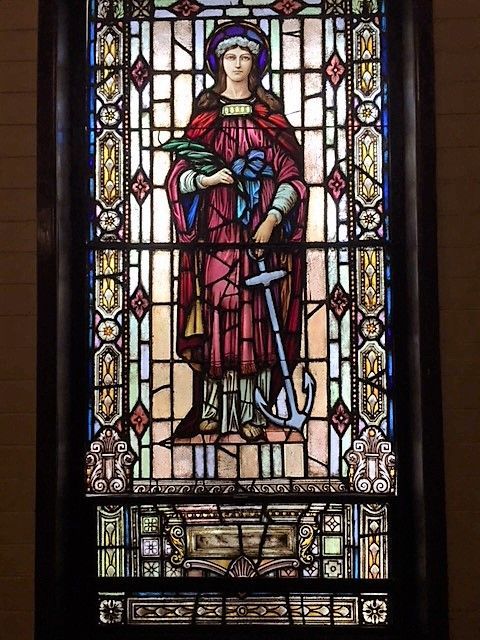St. Philomena
MADELEINE SOPHIE BARAT
This stained-glass window is on the right side facing the altar, 3rd from the front of the altar. She is holding an anchor and feathers.
In 1802, the bones of a female between the ages of 13 and 15 were discovered in the catacomb of St. Priscilla. An inscription near her tomb read "Peace be with thee, Philomena", along with drawing of 2 anchors, 3 arrows and a palm. Near her bones was discovered a small glass vial, containing the remains of blood. Because it was a popular custom of the early martyrs to leave symbols and signs such as these, it was determined that St. Philomena was a virgin and martyr.
Her popularity soon became widespread, with her most memorable devotees being St John Vianny, St. Madeleine Sophie Barat, St Peter Eymard, and St. Peter Channel. After being miraculously cured, Ven. Pauline Jaricot insisted that Pope Gregory XVI begin beatification of St. Philomena, who was to become known as the "wonder worker".

After hundreds of other miraculous cures, she was beatified in 1837. The Pope named St Philomena as the Patroness of the Children of Mary. She is the only person recognized as a saint solely based on her powerful intercession. There have been pertinent revelations regarding her life which have been recorded. Her relics are now preserved in Mugnano Italy.
One revelation was that she was a virgin being forced to shame by a powerful nobleman. When she refused his advances, he tried to have her executed by a firing squad of expert archers. When they fired their arrows, the arrows turned to feathers. When this failed, the nobleman ordered her to be tied to an anchor and thrown in the river, where she drowned. Her body did not stay underwater but rose to the top. Fellow Christians retrieved her remains and had them properly buried.
Our window shows her holding an anchor and feathers. The feathers symbolize the arrows shot at her that turned to feathers. The anchor symbolizes the way she was martyred.
Patronage: Babies, barrenness, bodily ills, children, children of Mary, desperate causes, forgotten causes, impossible causes, infants, infertility, lost causes, Living Rosary, newborns, poor people, priests, sick people, sickness, sterility, toddlers, young people, youth .





